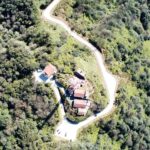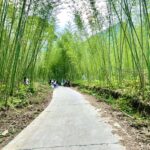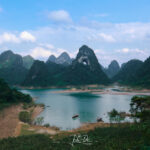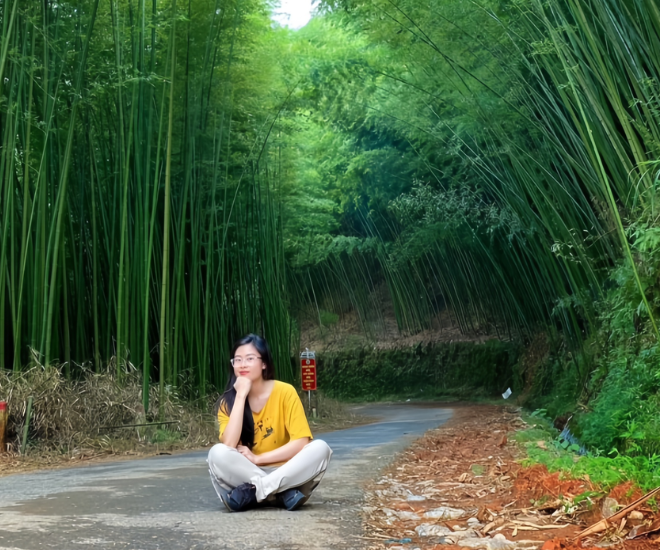
The Bamboo Forest of Nguyen Binh is situated in Phan Thanh commune, Nguyen Binh district, about 80km from the center of Cao Bang city. Perched at an altitude of around 1000 meters above sea level, this location offers a year-round cool climate, making it an ideal escape from the heat. It’s a perfect spot for those seeking fresh air and a chance to immerse themselves in nature.
What sets this forest apart is the dense and uniform presence of thousands of bamboo trees standing tall and covering the mountain slopes. As the wind blows through, the rustling sound of the bamboo creates a whispering effect, providing visitors with a sense of comfort and mystery.
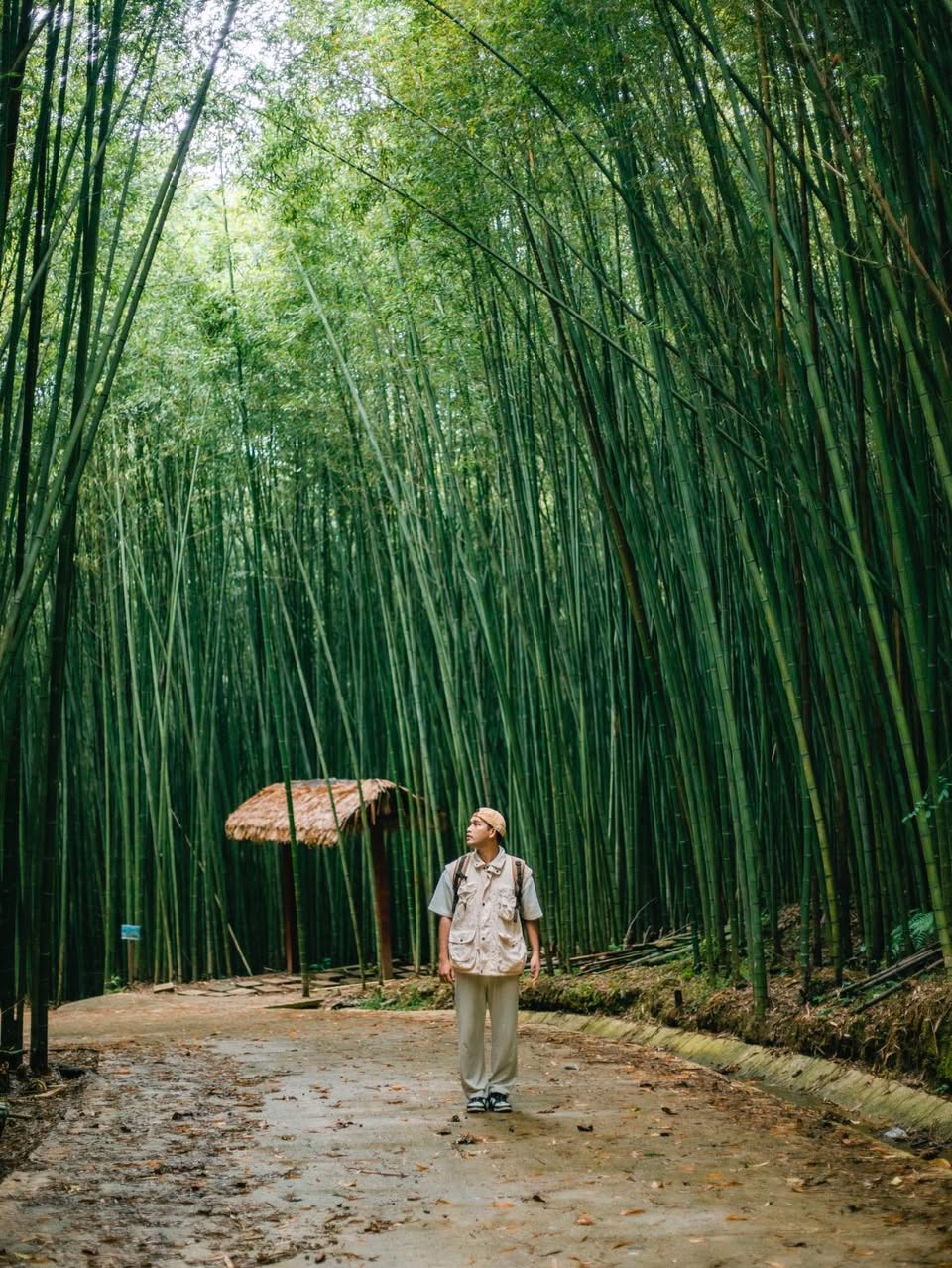
As you venture deeper into the forest, the surroundings become increasingly tranquil, almost like stepping into a movie scene. (Photo: Rọt’s Blog)
On foggy days, the bamboo forest transforms into a mystical labyrinth, blurring the boundaries between reality and fantasy. With its enchanting natural beauty, this place attracts tourists from all over and offers numerous Instagram-worthy spots.
Not only does the Nguyen Binh bamboo forest captivate nature lovers, but it is also a haven for trekking enthusiasts and those seeking sustainable tourism experiences. The trail through the forest stretches for about 5-7 kilometers, providing a challenging yet rewarding journey for adventurous souls.
Along the way, visitors have the opportunity to observe rare plant species, wild orchids, ancient fungi, and a diverse range of wildlife, including squirrels, white-browed fulvettas, and jungle fowls. If lucky, you might even encounter the local Dao ethnic community gathering herbs in the forest, carrying baskets filled with leaves—a cultural practice that has been preserved for generations.

Visitors are delighted by the scenery and atmosphere of this bamboo forest. (Photo: Rọt’s Blog)
It’s worth mentioning that the Nguyen Binh bamboo forest has retained its pristine and untouched charm, free from excessive commercialization often seen in other popular tourist destinations. Local authorities and the community have made dedicated efforts to preserve the natural landscape, prevent indiscriminate bamboo cutting, and develop eco-friendly trekking routes.
Beyond the enchanting bamboo forest, a visit to Nguyen Binh offers a range of exciting experiences. You can explore the famous Phia Den market, renowned for its unique local agricultural products, chase clouds at the peak of Phia Oac, visit a trout farm, and immerse yourself in the culture of the Dao Tien ethnic group in Hoai Khao village…

A bird’s-eye view of the Nguyen Binh bamboo forest.
Some local families have also started offering homestay services, providing accommodations and traditional dishes such as stir-fried bamboo shoots, grilled stream fish, and sticky rice cooked in bamboo tubes. These experiences leave lasting memories and showcase the potential for community-based tourism that preserves ecological and cultural heritage.
The Nguyen Binh bamboo forest is a year-round destination, but the dry season is ideal for convenient travel and the best photo opportunities. The dry weather also makes it easier to explore deeper into the forest, allowing visitors to fully appreciate its beauty.
Cao Bang Delicacies: A Culinary Journey
Cao Bang Egg Banh Cuon (Rolled Cake)
For the locals of Cao Bang, a typical breakfast often includes a unique variation of the classic Vietnamese rolled cake, known as egg banh cuon. Unlike the traditional versions found in other regions, Cao Bang’s egg banh cuon does not include meat fillings or accompaniments like Cha Que (Vietnamese pork sausage) or Giò Lụa (Vietnamese pork sausage). Instead, it is made by pouring a fresh egg directly onto the hot rice flour sheet, quickly rolling it up, and creating a creamy egg filling inside.
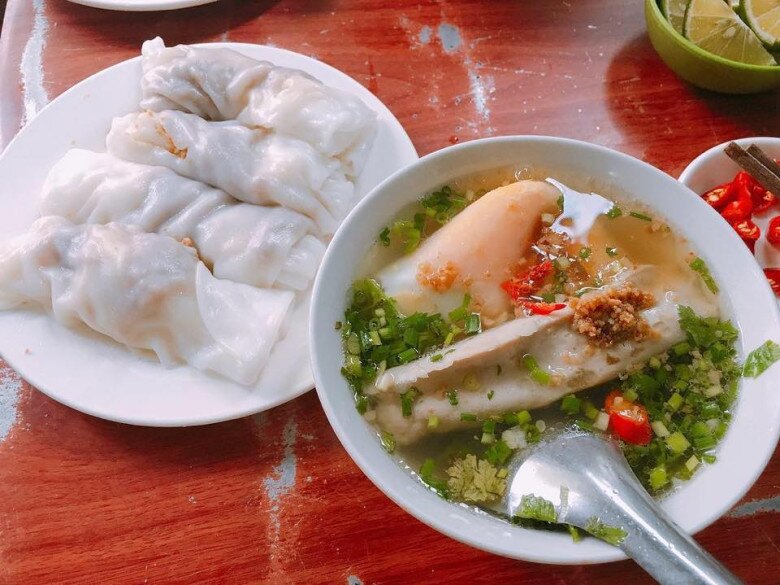
The distinctive feature lies in the dipping sauce, which is not the usual fish sauce but a hot bowl of bone broth seasoned with fried onions, creating a sweet and savory flavor.
When eating, the broth is poured directly onto the rolled cake, and a sprinkle of wild pepper and chili powder adds a spicy kick to the dish. This seemingly simple dish embodies the subtlety of seasoning and the heartfelt warmth of the highlanders. For many travelers, a morning in Cao Bang would be incomplete without tasting this soft and fragrant egg banh cuon.
Trùng Khánh Chestnuts
About 50km east of the city center, Trùng Khánh district is renowned not only for the majestic Ban Gioc Waterfall but also for its sweet and buttery chestnuts. Grown on limestone mountain slopes, these chestnuts absorb the cool climate and pure water from the streams, resulting in a superior flavor compared to those from other regions.

With their large size and rough shell, Trùng Khánh chestnuts reveal a golden, buttery interior when roasted or boiled. During the autumn harvest season, the aroma of roasted chestnuts fills the mountain roads, becoming an unforgettable characteristic of the region.
Locals often prepare chestnuts by roasting them over charcoal, seasoning them with salt, or incorporating them into baked goods, congee, and other dishes. Trùng Khánh chestnuts are not just a seasonal delicacy; they embody the essence of the land and the warmth of the people in this border highland region.
Phja Den Vermicelli
When it comes to Cao Bang specialties, Phja Den vermicelli is a must-mention, alongside egg banh cuon and Trùng Khánh chestnuts. This traditional noodle dish, made from dong riềng (a type of mountain potato), carries the essence of the northeastern mountains and the pride of the locals in Nguyen Binh district.
What sets Phja Den vermicelli apart is its pure ingredient—red dong riềng potatoes grown abundantly in this highland region. The intricate production process involves grinding the potatoes, filtering the starch, and naturally drying the noodles under the sun. The resulting brown-tinted noodles are naturally soft and chewy, without the use of any chemicals or additives. When cooked, Phja Den vermicelli retains its texture, taste, and slight sweetness, making it perfect for chicken noodle soup, stir-fries, or bone broth.
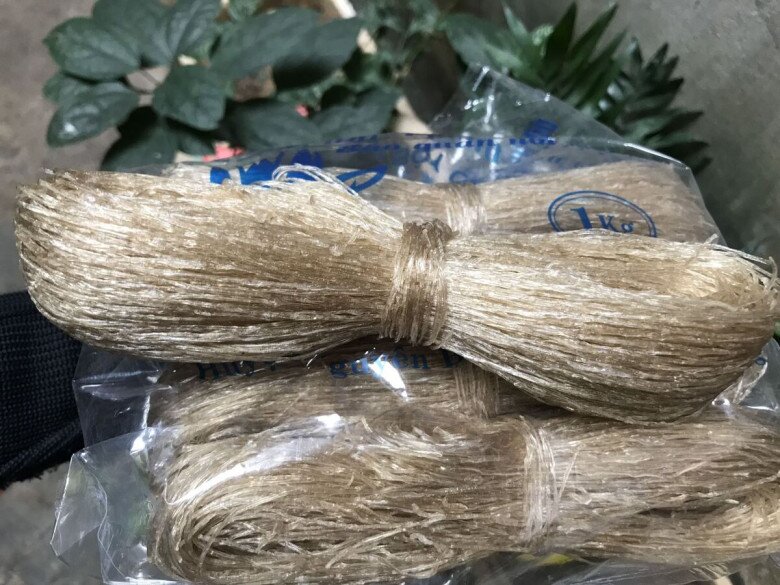
More than just a traditional dish, Phja Den vermicelli is a source of local pride and a meaningful gift for visitors to Cao Bang.
With its serene and captivating beauty, the Nguyen Binh bamboo forest attracts not only nature enthusiasts but also those seeking creative inspiration, meditation, and a return to the primitive values of life.
Unveiling the Pu Lu Bamboo Forest: A Cinematic Escapade in Bac Kan
Nestled approximately 10 kilometers from Ba Be Lake, the bamboo forest in Phieng Phang village (Pu Lau bamboo forest), Yen Duong commune, Ba Be district, is akin to a scene straight out of a martial arts movie. With its enchanting allure, this forest has become a tourist hotspot, attracting visitors eager to explore and capture memorable photos amidst its captivating surroundings.

























